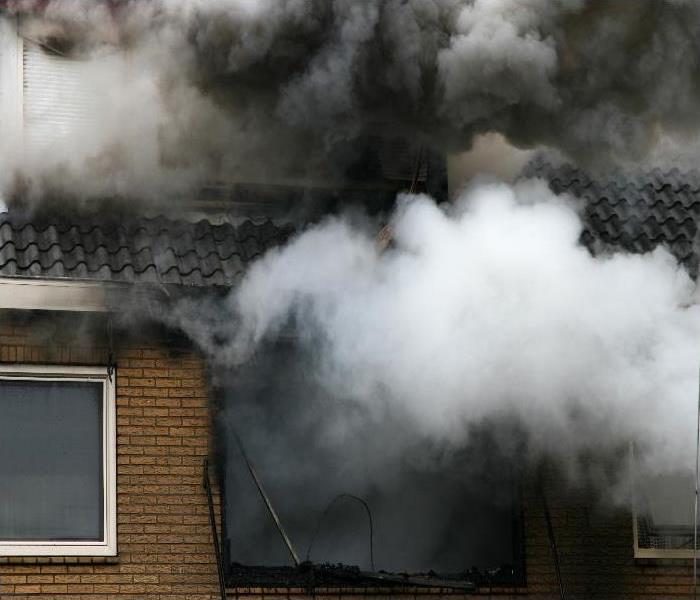Can Lockport Properties be Returned to Normal after a Fire Through Cleaning?
10/18/2020 (Permalink)
 Restoring an HVAC system can be time-consuming, but it is also essential to return your home to a preloss condition.
Restoring an HVAC system can be time-consuming, but it is also essential to return your home to a preloss condition.
Cleaning Smoke and Soot Residues is a Crucial Part of Fire Damage Restoration. SERVPRO Can Help Get your Lockport Residence Back to Normal.
How does smoke spread through a property?
Smoke damages are among the chief causes of concern for your Lockport home. While firefighting efforts can often contain the fire source, smokes are much more difficult to trap in one area. These chemical-filled gases rise upwards with heat and pressure while always seeking cooler air. The result is a structure that shows signs of smoke residues both in the area of damages and on walls and ceilings throughout. Since the residues come from the gas, they can reach and enter almost any spaces in the home. It is common to find smoke residues in cabinets, drawers, electrical fittings, textiles, and mechanical systems in the house. In some cases, an odorous smoke can permeate the building assembly itself, affecting insulation and assembly frames. Our technicians can help you to locate and remove the residues through established cleaning methodology and training.
Do Heating, Ventilation, and Air-conditioning (HVAC) systems need replacing after a fire?
Inspecting HVAC systems is an essential part of fire damage restoration in your Lockport home. The ductwork can transport hot smoke throughout the house and should be switched off, along with any electrics, immediately when a fire breaks out. Unfortunately, switching off the mains electrics is not always possible. That can lead to large amounts of smoke entering an HVAC system, overloading any inbuilt filters, and redistributing throughout the home. Cleaning a system like these is usually only necessary in situations where there is moderate to significant damages. Replacing an HVAC system is unnecessary unless there is material damage to the mechanics. If mechanical ducts are not cleaned during fire restoration, they can store smokes and redistribute them into the clean parts of the structure once power is restored.
What factors influence HVAC damage from the fire?
• The location of the fire is compared to the HVAC system and whether smoke has entered the return or supply side of the ductwork.
• The length of time that a housefire was burning before the flames where extinguished
• Whether the blower for the HVAC was in operation during the fire, although air-pressure can force smoke into a switched off the system as well.
What qualifications do you need to inspect an HVAC system?
Conducting repair of an air-conditioning system is a job for a specialist. However, fire restoration technicians can work with the non-moving parts of the system to clean and restore them. Some knowledge is required to understand what parts of a system could be damaged. Mechanical components like turning vanes, dampers, cooling coil, and mixing boxes should undergo tests to ensure there is no malfunction. Some of the parts can be replaced relatively cheaply. The ability to disassemble some or all of the HVAC system is also useful during the inspection to gain access to the interior ductwork and make an informed decision regarding the restoration requirements. If necessary, SERVPRO can arrange for a subcontractor to replace some or all of the HVAC systems, which can be included within your claim report allowing you to only deal with one point of contact during the service.
What approaches influence HVAC restoration?
• The material construction of the system, whether sheet metal, duct board or flex duct. Whether there is insulation in the ductwork.
• Are smoke residues severe enough to justify the system's disassembly and whether the mechanical components may need removing. HVAC disassembly is reserved for specifically qualified technicians
• The condition of the filters on both the return and supply side of the system. These may need cleaning or replacing
How do technicians clean ductwork?
Cleaning the ductwork of an HVAC system is an effective mitigation procedure against further damages and is often necessary for fire restoration. First, we remove air intakes and vent registers as well as air-handling filters. Negative air pressure or vacuuming can help to remove soots or dust from inlets and outlets in the system. Accessible areas can also be washed. Duct sealer can be applied to the HVAC using fogging equipment and the HVAC systems blower to distribute and is an efficient way of controlling malodors that may occur due to the fire.
What parts of HVAC fire damage affect a home?
• The type of smoke residues that are present within the ductwork
• The extent of residue, whether major, moderate or minor
• The presence of malodor
Restoring an HVAC system can be time-consuming, but it is also essential to return your home to a preloss condition. Contact SERVPRO of Eastern Niagara County at (716) 694-7776.






 24/7 Emergency Service
24/7 Emergency Service